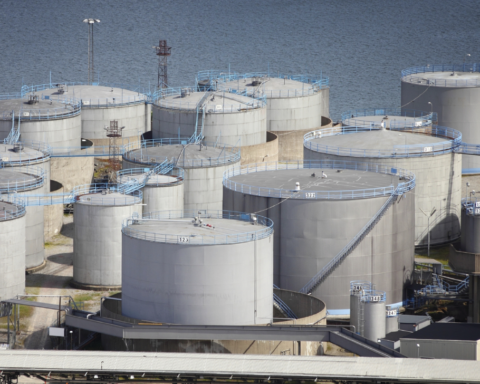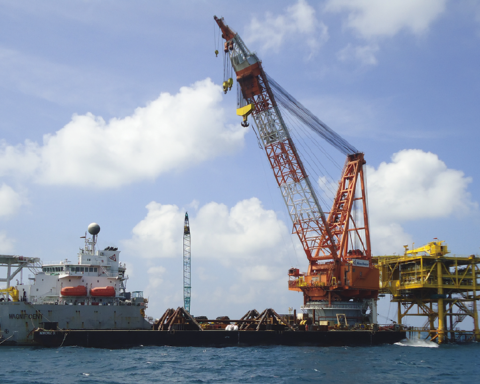Denis Deryushkin – head of the Directorate «Analytical Center of the Fuel and Energy Sector» of the FSBO «Russian Energy Agency» at the Ministry of Energy of Russia
Uncertainty is the key word characterizing the behavior of the world oil markets over the past several years. This uncertainty is associated with various factors: the probable recession of the global economy, trade wars, sanctions pressure. Obviously, they have a direct impact on the world oil market, but industry-specific drivers are also added to them: growth of shale production in the USA, performance of the agreement by OPEC+ countries. Recently, however, another parameter has been added to the list – production recovery rate in Saudi Arabia after the drone strike on the Saudi Aramco facilities in Abqaiq.
Current Situation
Despite the fact that the balance of oil markets is completely unpredictable and depends on many variables, four key factors can be distinguished among them. The first is a slowdown in the global economy, as evidenced by many macroeconomic indicators. For example, the business activity index (PMI) has been steadily decreasing since last summer, while the amount of debt with negative interest rates over the same period has grown 2.5-fold to USD15 trillion, and now accounts for a full 15% of the entire bond market.
The second significant factor is growth in US production, which slowed against the relatively-low oil prices in 2019, the gradual depletion of «sweet spots» and the growing need for additional drilling to maintain a constant level of production. The latter is caused by the specific features of shale deposits: the flow rate of wells is dropping rapidly, and the drilling of new wells is required. Thus, according to forecasts by the International Energy Agency (EIA) in October 2019, oil-production growth will slow to 0.87 million barrels per day, which will represent the lowest growth rate since September 2017. On the other hand, the continuing decline in the production breakeven price and launch of new pipelines in the USA supports an expectation of new US production records in 2020.
The global demand growth rate will continue
to slow from 1.5 Mmbd in 2018 to 1 Mmbd in 2019. This is one of the weakest growth rates
The next important factor is the growing uncertainty in the oil markets. The sanctions against Venezuela and Iran, the trade war between the United States and China, the civil war in Libya – all of these are contributing to the destabilization of supply and demand. And the recent attack against the oil fields of Saudi Arabia has demonstrated how quickly the situation on the market can change. Immediately after the incident, Saudi Aramco announced that it would halve its oil production – by 5.7 mln barrels per day, which represents roughly 5.7% of world production. As a result, Brent crude oil prices jumped by 19% to $72/bbl. It marked the biggest price increase at the opening of trading in the last 30 years. Such a nervous reaction was caused by fears of an emerging oil shortage on the market. Even setting aside the attack, according to estimates by the Analytical Center of the Fuel and Energy Sector, the oil market should be running a 1.4 Mmbd deficit in Q3 2019. However, this doesn’t actually mean that consumers won’t have enough oil. The markets are still well supplied. According to the IEA, OECD commercial reserves in July amounted to 2.9 billion barrels, which is only 20 million barrels below the 5-year average value. Saudi Arabia itself announced that in the near future it would compensate the market for the lost production by increasing production from September’s mark of 9.8 Mmbd to 11 Mmbd.

Source: J.P. Morgan, analysis by the Analytical Center of the Fuel and Energy Sector
And finally, the last-but-not-least factor is the OPEC+ agreement, which successfully balances the market and ensures stability for its players. In 2019 (January-August), its participants overfulfilled the agreement and kept production 1.2 Mmbd lower than the level of October 2018. In total, since January 2017, OPEC+ countries have a short delivery of more than 1.5 billion barrels to the market. This made it possible, by May 2019, to almost completely eliminate the surplus of reserves over the 5-year average level and make prices more predictable. In June, the agreement was extended by another nine months, through March 31, 2020. Thus, the high level of the agreement’s fulfillment will continue to make a significant contribution to stabilization of the market, despite the existing uncertainties.

Source: EIA, analysis by the Analytical Center of the Fuel and Energy Sector
Demand
According to ACFES forecasts, the global demand growth rate will continue to slow from 1.5 Mmbd in 2018 to 1 Mmbd in 2019. This is one of the weakest growth rates in the wake of the global crisis – only the 2012 growth rate of a meagre 0.93 Mmbd was worse. This decline is precisely the result of a slowdown in the global economy. According to estimates from our colleagues at the OPEC Secretariat, the global economy will grow at 3% in 2019 against 3.6% in 2018, with a slowdown in almost all the of the world’s key regions.

Table 1. Economic growth of the largest world economies
| GDP growth | 2018 | 2019 | 2020 |
| USA | 2,9% | 2,6% | 1,9% |
| EU | 1,9% | 1,3% | 1,6% |
| China | 6,6% | 6,2% | 6,0% |
| India | 6,8% | 7,0% | 7,2% |
Source: IMF, analysis by the Analytical Center of the Fuel and Energy Sector
In addition, the outcome of the conflict between China and the United States is still uncertain. In September, the new reciprocal import duties on goods become effective, and Chinese duties on oil from the United States are also increasing. While China has already redistributed its oil supplies, increasing the volume of imports from Saudi Arabia as well, it will not be as easy to change trade in other goods. Most likely, this will be reflected in higher prices for final consumers of goods, and it will artificially lower demand. A decrease in demand means a decrease in the transportation of goods and, accordingly, a decrease in oil consumption, which will be 0.1–0.2 Mmbd in 2020 according to forecasts by analytical agencies .
On the other hand, in January 2020, the new requirements of the International Maritime Organization (IMO) for marine fuel come into force. A sharp decrease in sulfur content – from 3.5% to 0.5% – will force oil refiners to mix marine fuel with diesel fuel due to the latter’s lower sulfur content. This will lead to an increase in demand for light petroleum products, which, in turn, will increase oil demand. Per various estimates, this growth will range from 0.15 to 1 Mmbd.
Proposal
The commissioning of the new Cactus II and EPIC pipelines scheduled for 2H 2019, with a total capacity of 2 million bpd over the mid-term, will allow the United States to increase oil production in the Permian Basin by a similar amount, since hydrocarbon transportation had represented one of the region’s bottlenecks. Production growth in the Permian Basin will become the key driver of all US oil production. Other oil formations will only compensate for the decline in old production. Thus, it is expected that US oil production in the second half of the year will increase to 12.5 Mmbd, + 1 Mmbd compared to the previous year. For 2019, overall production growth is projected at a level of 1.2 Mmbd. And in 2020, a slowdown of up to 1–1.1 Mmbd is expected.

Source: analysis by the Analytical Center of the Fuel and Energy Sector
The US sanctions against Iran and drop in Venezuelan production have led to a decrease in the supply of heavy oil on the market. Most of these losses were compensated by the United States possessing lighter and lower sulfur oil. On the eve of the new IMO rules, this situation could play into the market’s hands and contribute to a smoother transition to new marine fuels next year. However, the market cannot yet fully digest the production of light hydrocarbons, as is demonstrated by US oil reserves being at record-high levels (more than 1.3 billion barrels – roughly 60 mln bbl over the 5-year average level), and by increased WTI discounts to heavier oil grades. The high level of reserves, in turn, is exerting negative pressure on oil prices.

In July, the US Treasury Department prolonged the exemption of American oilfield-service companies from Venezuelan sanctions through October 25. After this date, however, they will have to leave the country. Thus, production in Venezuela has every chance of continuing its decline from 1.1 Mmbd at the beginning of this year to 0.6 Mmbd by the end of 2019. It is expected that the decline will continue in 2020 – average production will be 0.5 Mmbd (–0.23 Mmbd compared to the previous year).
Until March 2020, Russian production is expected to reach 100% of the agreement (11.2 Mmbd), and its further behavior will depend on the decision made to extend the deal. At the same time, I would like to note that Russia has significant potential for production growth (about 0.5 Mmbd), which can be used in case of necessity. As concerns Saudi Arabia, it’s making a decisive contribution to balancing the market by overfulfilling the terms of the agreement – the Kingdom’s production in August at 0.5 Mmbd below the level set by the agreement and 0.8 Mmbd below the level of October 2018. The recent drone strike could further extend this gap, but hopefully the attack won’t increase tensions in the Middle East or reduce the stability of supplies to consumers. This is also supported by the fact that the Kingdom has free capacities of about 1.2 Mmbd, which can be quickly activated.
On the whole, in 2019, the market may even remain at a deficit of 0.3 Mmbd. In many ways, this would be facilitated by the OPEC+ agreement. Next year, however, even taking into account the extension of the deal on its current terms, a market surplus of about 0.3 Mmbd is expected. Demand growth will be about 1.2 Mmbd, and oil production by countries outside OPEC+ will increase by 1.7 Mmbd, which will lead to the emergence of an oil surplus.

Source: Analysis by the Analytical Center of the Fuel and Energy Sector
Conclusions
The OPEC+ deal has been extended to March 2020, but it is unknown whether it will last for the whole year. At present, most of the production cutbacks within the framework of the agreement are being compensated by the increase in production by the United States and other countries outside the cartel. Under such circumstances, it might be reasonable to suggest that reducing production makes no sense, since non-OPEC countries make money both from the high price and from the supply of additional volume, while the deal’s participants lose out on part of their deserved profit. From another standpoint, in the absence of the deal, a surplus of more than 1.2 Mmbd would certainly hit prices hard and leave all market participants much worse off. Because of the oil industry’s long investment cycle, small tactical defeats are probably preferable to wild price volatility and even greater uncertainty.
| Key indicators | 2016 | 2017 | 2018 | 2019 | 2020 |
| Growth in world GDP, % | +2.8 | +3.4 | +3.2 | +2.7 | +2.7 |
| Growth in world oil demand, Mmbd | +1.2 | +2.0 | +1.5 | +1.0 | +1.4 |
| Growth in world oil production, Mmbd | +0.3 | +0.7 | +3.0 | -0.1 | +2.7 |
| OPEC production decrease, Mmbd | +0.8 | -0.1 | -0.1 | -2.0 | -0.1 |
| Production growth in non-OPEC countries, Mmbd | -1.1 | +0.4 | +2.0 | +1.4 | +2.0 |
| USA production growth, Mmbd | -0.6 | +0.5 | +1.6 | +1.4 | +1.1 |
| Anticipated change in reserves, Mmbd | +0.7 | -0.6 | +0.8 | -0.2 | +1.1 |
| Free oil-production capacities in the UAE, Kuwait | 1.7 | 2.4 | 2.0 | 2.8 | 2.8 |
| and Saudi Arabia, Mmbd | |||||
| Dated Brent (average annual, per barrel) | $44 | $54 | $71 | $65 | $64 |
| WTI-Cushing (average annual, per barrel) | $43 | $51 | $65 | $58 | $59 |
On the other hand, in November 2020, the USA will hold presidential elections and it is unknown whether the Middle East will want to maintain high oil prices during the primaries. However, even in the case of further concerted efforts to reduce production, a possible slowdown in economic growth, coupled by the trade war between China and the United States, could greatly reduce demand. The new IMO rules will probably be able to partially support it, but hardly to the full extent. Given the fact that the United States does not plan to significantly reduce its production, it is likely that the market uncertainty will persist next year as well.








